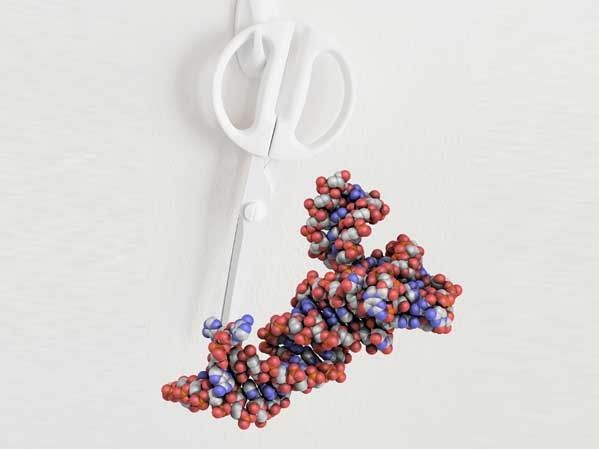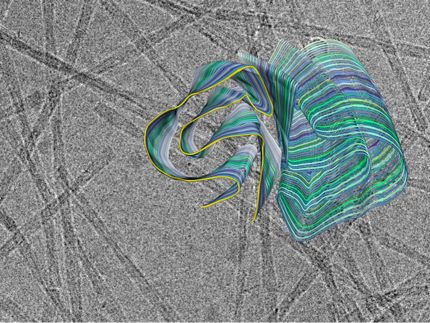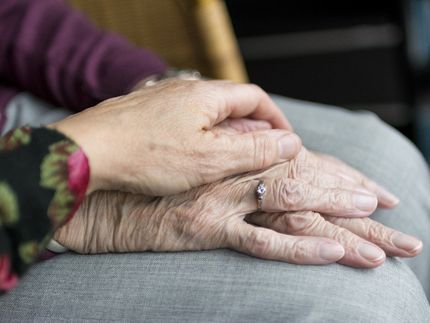Structural biology: Molecular scissors caught in the act
Structure of an enzyme crucial for tRNA maturation sheds light on cause of neurodegenerative disorders
In all living organisms, the biomolecule transfer RNA (tRNA) plays a fundamental role in protein production. tRNAs are generated from precursor molecules in several steps. The enzyme tRNA splicing endonuclease (TSEN), among other things, catalyzes one step in this process. Mutations in TSEN lead to a neurodegenerative disorder called pontocerebellar hypoplasia, which is associated with severe disabilities and early death. Researchers at Goethe University Frankfurt and at Johannes Gutenberg University Mainz have now deduced the function of TSEN from its structure and in so doing paved the way in the search for active substances against pontocerebellar hypoplasia.

Trimmed: Like scissors, the enzyme TSEN shapes tRNA (colored) by removing parts of the precursor molecule pre-tRNA.
Trowitzsch Lab, Goethe-Universität
Transfer RNAs (tRNAs) are among the most common types of RNA in a cell and are indispensable for protein production in all known organisms. They have an important “translation” function: They determine how the sequence of nucleic acids, in which the genetic information is encoded, is transcribed into a sequence of amino acids from which proteins are built.
Transfer RNAs are generated from precursor tRNAs (pre-tRNAs), which are converted in several steps into the mature tRNA with a complex three-dimensional structure. In some tRNAs, this includes a step in which a certain section, known as an intron, is excised. In humans, the tRNA splicing endonuclease (TSEN) performs this task.
The enzyme RNA kinase CLP1, which binds directly to TSEN, also plays a role in ensuring the correct conversion of tRNAs. If TSEN and CLP1 are unable to interact with each other due to a genetic mutation, it seems that tRNAs can no longer form correctly either. The consequences of this are often seen in the development of neurodegenerative disorders. One of these is pontocerebellar hypoplasia, which leads to severe disabilities and premature death in earliest childhood. This very rare progressive disorder manifests itself in an abnormal development of the cerebellum and the pons, a part of the brain stem.
Although TSEN activity is essential for life, it was to date mostly unclear how the enzyme binds pre-tRNAs and how introns are excised. The lack of a three-dimensional structure of the enzyme also made it difficult to assess the changes triggered by specific pathogenic mutations. By means of cryo-electron microscopy (cryo-EM) conducted at facilities of the Julius-Maximilians University of Würzburg and of the Institute of Biochemistry at Goethe University Frankfurt, researchers led by Dr. Simon Trowitzsch from the Institute of Biochemistry at Goethe University have now succeeded in shedding light on the three-dimensional structure of a TSEN/pre-tRNA complex.
With the aid of their cryo-EM reconstructions, the research team was able to show for the first time how TSEN interacts with the L-shaped pre-tRNA. TSEN then excises the intron from the long arm of the L. “First, TSEN settles in the corner of the L. It can then recognize both the short and the long arm as well as the angle between them,” explains Trowitzsch.
The TSEN subunit 54 (TSEN54) plays a key role in pre-tRNA recognition, as the researchers have now been able to corroborate. The subunit serves as a “molecular ruler” and measures the distance between the long and the short arm of the L. In this way, TSEN recognizes at which point the pre-tRNA needs to be cleaved in order to remove the intron.
New findings on the interaction of the RNA kinase CLP1 and the TSEN subunit TSEN54 were a surprise: CLP1 evidently binds to an unstructured and thus very flexible region of TSEN54. It is precisely this region that contains an amino acid most frequently mutated in patients with pontocerebellar hypoplasia. “For us, this is an important indication that drug development in the future should concentrate on maintaining the interaction of TSEN and CLP1,” Samoil Sekulovski, first author of the study, is convinced.
The scientists now hope that the structural data will make it possible to simulate models that can be used to search for potential active substances. Trowitzsch sums up: “Although a promising therapy is still a long way ahead of us, our structure indeed forms a solid foundation for a better understanding of how TSEN works and what the disease patterns of its mutants are.”




















































